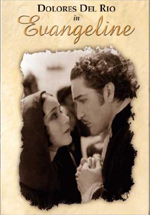Evangeline: A Tale of Acadie
Henry Wadsworth Longfellow's first epic poem, Evangeline: A Tale of Acadie, published in 1847, is a story of loss and devotion set against the deportation of the Acadian people in 1755. The poem elevated Longfellow to be the most famous writer in America and has had a lasting cultural impact, especially in Nova Scotia and Louisiana, where most of the poem is set.
On April 5, 1840, Longfellow invited a few friends to dine at his rented rooms in Cambridge at the Craigie House. Nathaniel Hawthorne brought the Reverend Horace Conolly with him. At dinner, Conolly related a tale he had heard from a French-Canadian woman about an Acadian couple separated on their wedding day by the British expulsion of the French-speaking inhabitants of Nova Scotia. The bride-to-be wandered for years, trying to find her fiancé. Conolly had hoped Hawthorne would take the story and turn it into a novel, but he was not interested. Longfellow, however, was intrigued, and reportedly called the story, "the best illustration of faithfulness and the constancy of woman that I have ever heard of or read." He asked for Hawthorne's blessing to turn it into a poem.
Seven years after Longfellow first heard the story, Evangeline was published. During that time, he continued his Harvard professorship and published several books, including volumes of his own poetry, translations, and a novel, Hyperion. He also married Frances (Fanny) Appleton, became the owner of Craigie House when her father gave it to the newlyweds as a wedding gift, and had three children, the third christened two days before the official publication of Evangeline.
By 1845 when Longfellow began working on the poem, the fate of the Acadians had largely been forgotten. Longfellow researched the basic history of the expulsion at the Harvard library and the Massachusetts Historical Society. He learned that the French began to settle Acadie, modern-day Nova Scotia, in 1604. For the next 150 years, they cultivated the land, maintained a friendly relationship with the native Micmac Indians, and remained neutral in the ongoing conflicts between the French and the English. By the mid-18th century, there were 12,000 to 18,000 Acadians. In 1755 when these British subjects refused to take up arms against the French, they were exiled from their lands, in what the Acadians call "Le Grand Dérangement." The Acadians were scattered far and wide. Many eventually ended up in Louisiana where they formed the basis of the Cajun culture.
According to Longfellow biographer Charles Calhoun, "As was his poetic practice, once Longfellow had briefed himself on the factual background, he used his material with a very free hand. He was a bard, not a historian; what mattered was the basic human truth of his story, not its particulars." Evangeline is a work of fiction; Longfellow devised its heroine and her quest, as well as the scenery that she moves through. The poem even starts on a fictional note: "This was the forest primeval" is a better description of the coast of Maine, where Longfellow grew up, than the low-lying marshlands of Acadia, which he had never visited.

Dolores del Rio as Evangeline and Roland Drew as Gabriel in the 1929 version of Evangeline
Factual or not, Longfellow's Evangeline became a huge success. The poem went through six printings in the first six months after being published, and within ten years had been translated into a dozen languages. The poem has been made into two films, one in 1922 and the second, starring popular silent film actress Dolores Del Rio, in 1929. Generations of American children read, memorized, and recited the poem as part of their schooling. Schools, churches, inns, and many other businesses and social groups were named for the poem's heroine.
Other authors capitalized on the success of the poem by writing alternate versions of the story. Louisiana Judge Felix Voorhies published Acadian Reminiscences: The True Story of Evangeline, in 1907. In his telling, the lovers are reunited under an oak tree in the Louisiana town of St. Martinville, but when Evangeline discovers that Gabriel has fallen in love with another woman, she goes mad and dies. This version became very popular in Voorhies' home state, where his novel was often taken as historical fact.
Longfellow's Evangeline created a tourist industry in the lands of the Acadians. Visitors are still drawn to sites such as the Longfellow-Evangeline State Historic Site in Louisiana, which interprets the lifestyle of the Acadian settlers. Once there, it is just a short ride to St. Martinville to see the "Evangeline Oak" which features so prominently in Voorhies' version of the story. In Nova Scotia, the Evangeline Trail stretches along the Bay of Fundy coast from Yarmouth to Grand Pré and beyond.
Evangeline's most lasting impact has been on Acadians themselves, both in Nova Scotia and in Louisiana. According to Yale historian John Mack Farragher, author of A Great and Noble Scheme: The Tragic Story of the Expulsion of the French Acadians from their American Homeland, "[T]he poem struck a spark igniting a cultural and political renaissance among the small Acadian middle class that began to emerge in the second half of the nineteenth century." The poem became a creation myth, and its heroine's hometown of Grand Pré remains a pilgrimage site. In 2004, to commemorate the four hundredth anniversary of the arrival of the French in North America, a two-week reunion was held there. Thousands of Acadians from around the world gathered to celebrate their shared history.
Evangeline was Henry Wadsworth Longfellow's first epic poem. Hiawatha (1855), "Miles Standish" (1858), and Tales of a Wayside Inn (1863-1873) followed, cementing Longfellow's reputation as the preeminent mythmaker of his country's young history.




